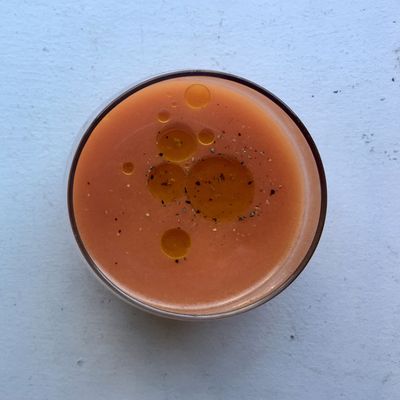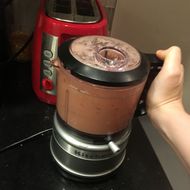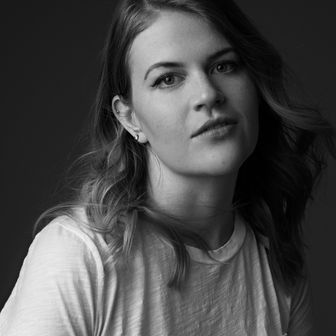
Over Easy is a weekly food column by a 20-something woman who can barely cook an egg and just wants to learn how to throw together an elegant three-course meal for her friends.
At some point every summer, someone suggests gazpacho: “It’s just so so refreshing!” According to Food & Wine, “during the dog days of summer, there’s no better way to cool off” than with a “refreshing bowl” of the cold Andalusian soup. In my experience, however, gazpacho hasn’t been “refreshing” so much as it’s been “super gross.”
The first time I had gazpacho, I was 10. I was sitting in my grandparents’ kitchen in California, in the little yellow house on the hill that my great-grandfather built, and where my grandpa Geoff grew up. Geoff was excited — he didn’t generally cook, but he was proud of his gazpacho.
“Gazpacho is really good for you,” he told me, puttering around the kitchen, chopping and blending, while my grandparents’ Australian shepherd, Ben, and I watched apprehensively. “It’s full of vegetables, and it’s cold, so it’s nice on a hot day like today.”
As a 10-year-old girl whose diet consisted largely of hot dogs and Twix bars, I was unconvinced. Nor was I reassured when he pushed a bowl of thick, copper-colored sludge toward me. It both tasted like and had the consistency of wet cardboard. I scarfed it down so we could go take Ben to the beach, and then avoided gazpacho entirely for many, many years.
But a couple of weeks ago, someone mentioned how much they love gazpacho and, being highly impressionable, I decided to give it a second chance. After looking around, I found a recipe from Julia Moskin at the New York Times for the “Best Gazpacho” (great sign), which is “more of a drink than a soup,” and is not “the watered-down salsa or grainy vegetable puree often served in the United States,” specifically at my grandparents’ house.
This gazpacho recipe had fewer ingredients than some of the more elaborate ones I saw — two pounds of tomatoes, a cucumber, a small onion, a clove of garlic, some sherry vinegar, and half a cup of olive oil, as well as cubanelle pepper. I wasn’t sure what a cubanelle was, but according to the comments, it was very important to get exactly that, or some other “long, light green pepper.” Luckily, when I went to Whole Foods after work on Monday, the cubanelles were clearly labeled, and I spent far less time than usual wandering confused and scared around the produce section, and I only got into one (1) altercation with a woman who tried to shove me away from the tomatoes. Overall, a successful grocery trip.

According to Moskin, the prep time for this dish is only about 20 minutes. And that’s probably true, if you have a real blender. My only two options, though, were a tiny NutriBullet or a slightly less tiny food processor — I had to blend up the vegetables, olive oil, and sherry vinegar in five small batches, instead of all at once, which took closer to 40 minutes. I then strained the reddish-orange mixture through a metal sieve, and tossed the solids in the trash (“It looks like raw hamburger,” noted my roommate). When I was finally done, I felt slightly cheated by how little soup my mountain of vegetables had produced, but I guess it’s “more of a drink than a soup.”
Before work the next morning, I packed myself some gazpacho and spelt bread. Lunch was hours away, but I preemptively felt quite sorry for myself, a woman with a very meager, cold meal ahead of her. In anticipatory hunger, I began mapping out potential snacks, like vending machine chips, or one of those overpriced protein bars from the place downstairs.
I was walking down the stairs to the 3 train when my dad called about Geoff. After he told me the news, I ducked behind some stairs and pressed my forehead against the grimy wall to hide my tears. Not that it mattered — everyone was too busy with their own phones and lives to notice the woman sobbing against a urine-stained wall. Say what you will about New York, but it’s a great place to cry in public.
Then I told my boss what happened, and went home. Later, I ate the gazpacho in my bed. It didn’t transport me back to that afternoon in the little yellow house. It didn’t make me feel like Geoff was alive, or with me, or like I could hear his voice, or whatever other cinematic bullshit I half-expected or foolishly hoped for. But it didn’t demand anything of me either. It was a very polite dish to grieve with. It quenched some of my tear-induced dehydration, cooled my flushed face, filled my twisted, writhing stomach just a little, just enough. It was the culinary equivalent of a cool towel on your forehead when you have a fever — it doesn’t fix anything, and your body is still on fire, but for a moment, at least, it’s a small, welcome relief.
I wanted to tell Geoff about how the gazpacho turned out; to call him and remind him of that afternoon, and our hikes, and the time he taught me to bodysurf, choosing the perfect wave and racing it until it catches you and you’re weightless, flying — all the times he was so brilliantly, vibrantly alive that he made me feel more alive, more brilliant. But I can’t now, so I’ll tell you.
The next day, I brought some of the gazpacho into the office for lunch. I still felt nauseous, but I could actually taste it this time. The texture was smooth, but substantial. The heat of the cubanelle and the bite of the onion both cut through and elevated the coolness of the tomatoes and cucumber, and even though it was light, it kept my hunger at bay for most of the day.

It was very good, definitely better than Geoff’s gazpacho. I think he would be okay with me saying that. It would probably be nice to have on a hot afternoon in your backyard, or as an appetizer before a big dinner with friends. Or, if you’re alone and you’re sad, it will give you the space to grieve. That, I think, is very refreshing.


